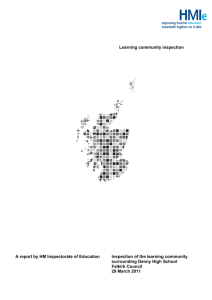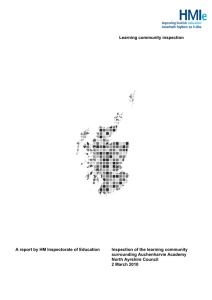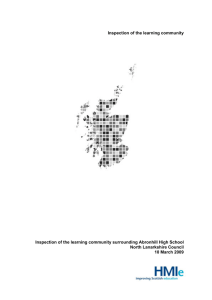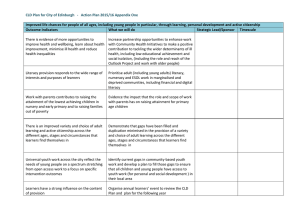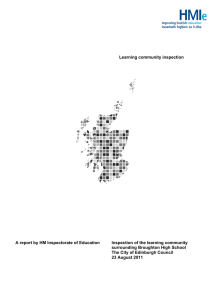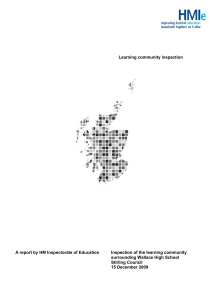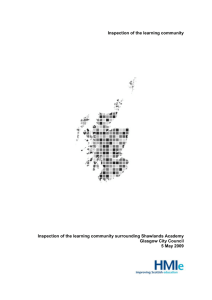Learning community inspection A report by HM Inspectorate of Education
advertisement
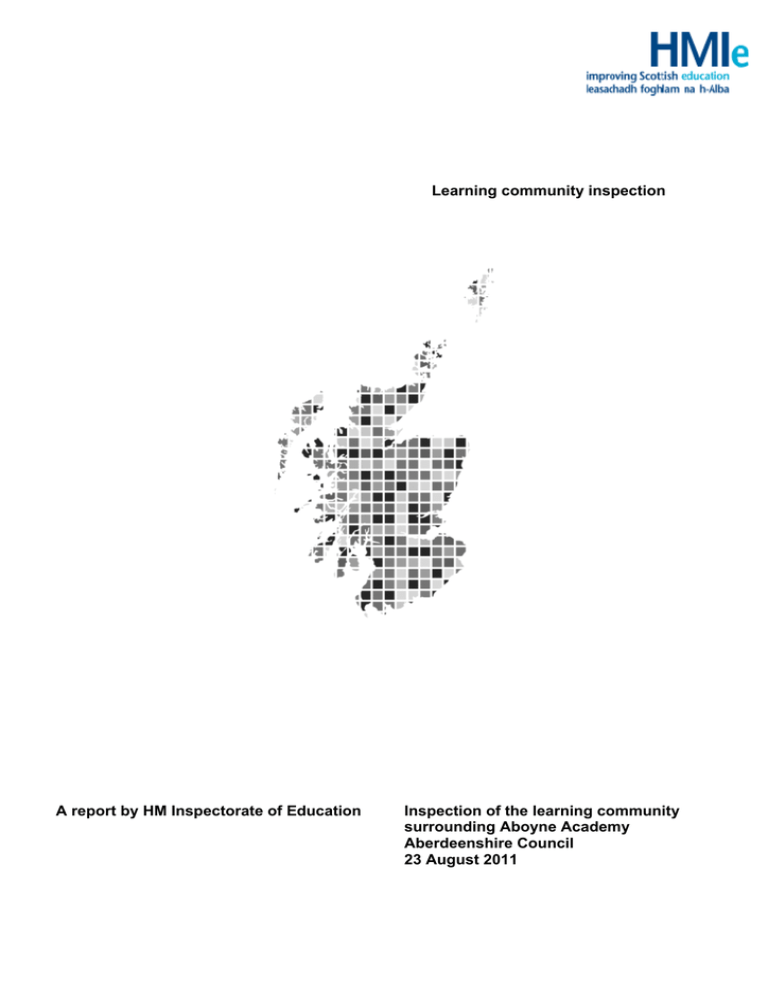
Learning community inspection A report by HM Inspectorate of Education Inspection of the learning community surrounding Aboyne Academy Aberdeenshire Council 23 August 2011 We inspect learning communities in order to let those who use services and the local community know whether learning communities provide appropriate learning opportunities and help learners in their development. We are also interested in how community and voluntary groups are helped to contribute to making communities better places to live and work. At the end of inspections, we agree ways in which staff and volunteers can improve the quality of learning for young people and adults and how the impact of community and voluntary groups can be further developed. At the beginning of the inspection, we ask managers and staff about the strengths of the learning community, what needs to improve, and how they know. We use the information they give us to help us plan what we are going to look at. During the inspection, we join other activities which young people, adults and community groups are involved in. We also gather the views of learners, active community members and staff. We find their views very helpful and use them together with the other information we have collected to arrive at our view of the quality of provision locally. This report tells you what we found during the inspection and the quality of learning and development provided. We describe how well learners are doing and how good the learning community is at helping them to learn. We comment on how well staff, learners and groups work together and the difference they are making in the learning community. Finally, we focus on how well the learning community is led and how leaders help the learning community achieve its aims. If you would like to learn more about our inspection of the learning community, please visit www.hmie.gov.uk. Contents 1. The learning community 2. Particular strengths of the learning community 3. How well do participants learn and achieve? 4. How well are communities developing and achieving? 5. How effective are providers in improving the quality of services? 6. Does the learning community have a clear sense of direction? 7. What happens next? 1. The learning community The learning community around Aboyne Academy lies within an area of rural Aberdeenshire. The population of approximately 11,000 is centred mainly in and around Aboyne, Ballater and Braemar and in a number of smaller villages. The proportion of elderly people is high. In addition to jobs in the oil industry, the main sources of employment are tourism, agriculture and forestry. The area is more affluent than the national average and the level of unemployment is low. There is a high level of engagement by the local community in planning for the Marr area. Availability of affordable housing is a major issue for local people. 2. Particular strengths of the learning community • Highly committed and effective volunteer community representatives. • Outstanding, vibrant and active community organisations. • Strong levels of community engagement in local community planning. • High quality English for speakers of other languages (ESOL) work. • Confident, articulate and motivated young people. 3. How well do participants learn and achieve? Strong and effective community groups and organisations are involving large and increasing numbers of local people in developing and improving their communities. Marr area monitoring tables are used to review and report on progress against targets set in local area community plans. These show some good examples of improvements in performance and strong impact on local communities. Vibrant community groups have ambitious plans and are making good progress. The quality of community learning and development (CLD) activities is high in work with community trusts and provision of ESOL. CLD staff are beginning to improve systems for monitoring progress in youth work and adult learning but currently these mainly report only numbers taking part. Targets set for accreditation of youth achievement and for numbers engaged in adult literacy and numeracy are not sufficiently ambitious. Numbers engaged in adult literacy and numeracy are very low. There are too few local opportunities for learners to gain qualifications. There is too little information on the impact of work with young people and adult learners. Improved sharing and tracking of young people’s achievement across youth work providers in the area and with the school would improve provision overall. 1 Young people Young people are confident, articulate and motivated and they participate effectively in the life of the community. They develop team-working, leadership and other skills through their involvement in sports, arts, cultural and community activities. Community Trusts and voluntary groups work hard to involve young people and actively seek their views on their priorities for the area. Young people in the cinema project in Tarland are working effectively and developing more confidence through taking part in detailed consultation. They are now involving younger age groups in their project. Those campaigning for a local skate park in Aboyne demonstrate confidence and an ability to clearly present their case. Young people in Logie Coldstone enthusiastically lead activities for younger age groups including a regular junior youth club. There are good examples of intergenerational work including the Junior Highland Games Forum through which young people now successfully run a popular annual games event. Better communication and joint planning between CLD and school staff to improve quality and programme design would improve learners’ experiences overall. There are too few opportunities for young people to gain accreditation of achievement in youth work which results in missed opportunities to celebrate high levels of peer leadership. A clearer partnership approach would enable better provision of information on aspects of health. There is insufficient overview of the impact of young people’s participation across voluntary and public sector groups and organisations. Staff have not yet taken sufficient account of Curriculum for Excellence in youth work planning. Staff now need to better assess learning and track progression against the experiences and outcomes. Adults Adults involved in local voluntary community groups are developing confidence and learning skills in aspects of management, planning, consultation, communication and committee work. A few volunteers have gained qualifications, for example, through working with Homestart in the Marr area. Work with ESOL learners is of a high quality. Tutors are highly responsive to learners’ needs and adapt programmes accordingly. ESOL learners are making very good progress. Their confidence has improved and developments in their understanding of English has improved their employment opportunities, earnings and access to health services. The number of literacies learners is very low with all provision delivered on a one to one basis. Improved opportunities to link literacy and numeracy skills to wider work with adult community groups are needed. More effective communication with partners, including the library service and health professionals could improve engagement with more vulnerable adults. There are few local opportunities for adults to gain qualifications. Delivery and planning of adult learning and training relevant to the needs of the local economy is too limited. Staff find it difficult to attract the minimum number of learners to access Aberdeen College’s outreach service. Older adults would appreciate access to more self-managed informal learning opportunities at the Deeside Centre. There is scope to address some of the constraints on provision through better joint planning and communication between CLD, school and library staff. 2 4. How well are communities developing and achieving? Highly committed, confident and well-informed volunteer community members have an outstanding impact on the development of local communities. Very high levels of engagement in community planning has enabled communities to develop a clear shared vision and direction. Vibrant community development groups, community trusts and social enterprises operate with increasing levels of success within Marr Area Partnership. Groups are successfully securing funding and other resources to implement ambitious plans. Clear and robust structures support effective community leadership. Groups have established clear and carefully considered plans following extensive and successful consultation exercises with local residents. Highly motivated community representatives place a high value on the support and guidance provided by CLD staff, Area Managers and staff from the Cairngorm National Park Authority (CNPA). Group members are very well informed on community need and long term plans for housing and economic development. They have a strong influence in shaping area plans. In Braemar, the local community trust has established community management of the castle and are now actively working together on a highly ambitious project to improve it as a visitor attraction and community resource. Members are developing projects to promote tourism, local history and environmental improvements. Young people from Aboyne Academy are actively engaged in developing a high quality exhibition on local history in the castle. Ballater One Voice Our Future has achieved a very high degree of involvement by the local community in its plan for the development of the village. Improvements to the local sports facilities and the park have been carried out as a first step towards implementing their ambitious plans. Logie Coldstone Community Trust manage the community hall, run community events and support full community involvement in planning for housing, education and other services. Community groups communicate effectively together, share resources and information and learn well from each other’s experience. Communication through high quality local newsletters, reports, websites and regular events is very effective. Groups have made substantial efforts to ensure that young people contribute their views to planning. Confident community members are justifiably proud of the achievements of their organisations. They reflect carefully on their work and are clear about what they want to improve. 5. How effective are providers in improving the quality of services? Communities have a strong voice in identifying local priorities and improvements. Monitoring and reporting on progress by community trusts is very effective. Stakeholders in community planning are informed of progress through regular village newsletters and community events. There are good examples of outcome-focused reports and action plans within the Marr Area Partnership. Most CLD staff reflect effectively on the quality of their work and use feedback from participants on programmes to consider improvements. However, meetings of the Aboyne Children’s Services Network have been infrequent and as a result stakeholders have been unable to contribute to reviews in some aspects of work. Clearer and more outcome-focused evaluation and planning is needed in youth 3 work and adult learning. Staff now need to improve their use of work planning systems that include clear achievements and priorities for improvement. Improvement in information gathering, communication with partners and analysis of need is required to make planning for improvement more effective. 6. Does the learning community have a clear sense of direction? Marr Area Partnership provides a strong and sustainable framework to support local communities and community groups have a very clear sense of direction. Support to build community capacity is highly effective. Joint working and planning amongst CLD, Area Managers and CNPA is strong. Staff deployment, development and capacity across CLD priorities requires review and clearer priority setting for youth work and adult learning is needed. 7. What happens next? There are some important improvements needed, but because CLD providers have a good understanding of their strengths and areas for improvement, and communities are achieving well, we have ended the inspection process at this stage. We will monitor progress through our regular contact with the education authority. We have agreed the following areas for improvement with the local authority and its partners. • Develop a systematic approach to planning for improvement at a local level. • Set clear priorities with partners for the delivery of adult learning. • Work with partners to increase opportunities for accreditation in youth work. Quality indicators help CLD providers and inspectors to judge what is good and what needs to be improved in the learning community. You can find these quality indicators in the HMIE publication “How good is our community learning and development? 2”. 4 HMIE checks five important quality indicators to keep track of how well all Scottish CLD provision is doing. Here are the results for the learning community surrounding Aboyne Academy. Improvements in performance Impact on young people Impact on adults Impact of capacity building on communities Improving services Managing Inspector: Peter Hamilton 23 August 2011 5 satisfactory satisfactory satisfactory excellent satisfactory This report uses the following word scale to make clear judgements made by inspectors. excellent very good good satisfactory weak unsatisfactory outstanding, sector leading major strengths important strengths with some areas for improvement strengths just outweigh weaknesses important weaknesses major weaknesses If you would like to find out more about our inspections or get an electronic copy of this report, please go to www.hmie.gov.uk. Please contact us if you want to know how to get the report in a different format, for example, in a translation, or if you wish to comment about any aspect of our inspections. You can contact us at HMIEenquiries@hmie.gsi.gov.uk or write to us at BMCT, HM Inspectorate of Education, Denholm House, Almondvale Business Park, Almondvale Way, Livingston EH54 6GA. Text phone users can contact us on 01506 600 236. This is a service for deaf users. Please do not use this number for voice calls as the line will not connect you to a member of staff. You can find our complaints procedure on our website www.hmie.gov.uk or alternatively you can contact our Complaints Manager, at the address above or by telephoning 01506 600259. Crown Copyright 2011 HM Inspectorate of Education
